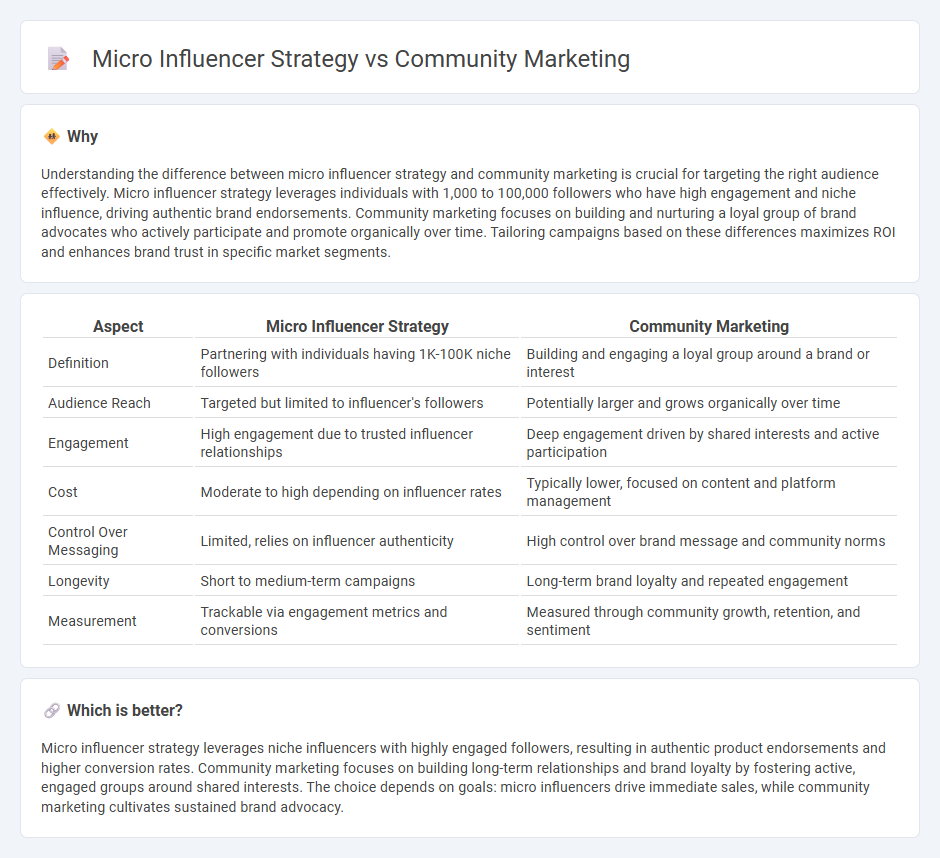
Micro-influencer strategy targets niche audiences through authentic voices with high engagement rates, leveraging influencers who have a smaller but more dedicated follower base to drive brand awareness and conversions. Community marketing focuses on building deeper relationships within specific groups or communities by fostering trust and encouraging user-generated content to enhance loyalty and advocacy. Discover how combining these approaches can maximize your brand's reach and engagement.
Why it is important
Understanding the difference between micro influencer strategy and community marketing is crucial for targeting the right audience effectively. Micro influencer strategy leverages individuals with 1,000 to 100,000 followers who have high engagement and niche influence, driving authentic brand endorsements. Community marketing focuses on building and nurturing a loyal group of brand advocates who actively participate and promote organically over time. Tailoring campaigns based on these differences maximizes ROI and enhances brand trust in specific market segments.
Comparison Table
| Aspect | Micro Influencer Strategy | Community Marketing |
|---|---|---|
| Definition | Partnering with individuals having 1K-100K niche followers | Building and engaging a loyal group around a brand or interest |
| Audience Reach | Targeted but limited to influencer's followers | Potentially larger and grows organically over time |
| Engagement | High engagement due to trusted influencer relationships | Deep engagement driven by shared interests and active participation |
| Cost | Moderate to high depending on influencer rates | Typically lower, focused on content and platform management |
| Control Over Messaging | Limited, relies on influencer authenticity | High control over brand message and community norms |
| Longevity | Short to medium-term campaigns | Long-term brand loyalty and repeated engagement |
| Measurement | Trackable via engagement metrics and conversions | Measured through community growth, retention, and sentiment |
Which is better?
Micro influencer strategy leverages niche influencers with highly engaged followers, resulting in authentic product endorsements and higher conversion rates. Community marketing focuses on building long-term relationships and brand loyalty by fostering active, engaged groups around shared interests. The choice depends on goals: micro influencers drive immediate sales, while community marketing cultivates sustained brand advocacy.
Connection
Micro influencer strategy leverages individuals with highly engaged, niche audiences to foster authentic connections, which amplifies community marketing efforts by cultivating trust and active participation. Community marketing focuses on building a loyal base around shared interests and values, which micro influencers naturally embody and promote through personalized content. Together, they create a symbiotic relationship that drives brand awareness, engagement, and long-term customer loyalty within targeted market segments.
Key Terms
**Community Marketing:**
Community marketing builds brand loyalty by fostering authentic engagement and creating a dedicated customer base around shared interests or values. It leverages user-generated content, real-time feedback, and personalized interactions to deepen trust and drive long-term growth. Discover how community marketing can transform your brand's relationship with its audience for significant impact.
Brand Advocacy
Community marketing builds brand advocacy by fostering authentic relationships and long-term engagement within a dedicated customer base. Micro-influencer strategy leverages niche influencers with highly engaged audiences to generate trust and amplify brand messages on a smaller, more targeted scale. Explore how integrating both approaches can maximize brand loyalty and advocacy.
Engagement
Community marketing leverages brand-loyal groups to foster authentic interactions and sustained engagement, boosting trust and customer lifetime value. Micro-influencer strategies target niche audiences through individuals with smaller, dedicated followings, resulting in higher engagement rates and personalized content resonance. Explore how combining these approaches can maximize your brand's engagement and growth potential.
Source and External Links
Community Marketing 101: Basics, Strategies, and Examples - Upwork - Community marketing focuses on building strong relationships with customers through interactive strategies such as social media communities, user-generated content, brand advocacy, forums, co-creation, exclusive memberships, and community events to foster trust and brand loyalty.
What is community marketing? - Community marketing is a collaborative strategy that requires clear objectives, a welcoming environment, unique value, peer-to-peer interaction, and specialized tools to successfully engage and retain a loyal customer base.
What is community marketing and how to start | Khoros - Community marketing creates deeper, personalized connections with customers by building a dedicated brand community where members share experiences, feedback, and help shape brand direction, leading to increased advocacy and engagement.
 dowidth.com
dowidth.com